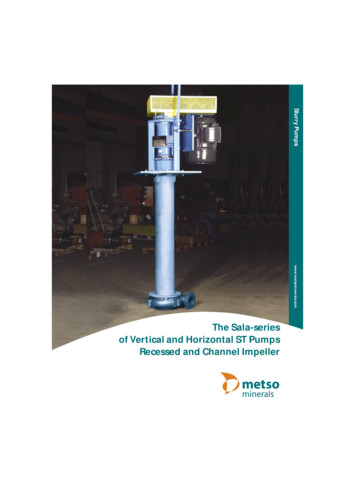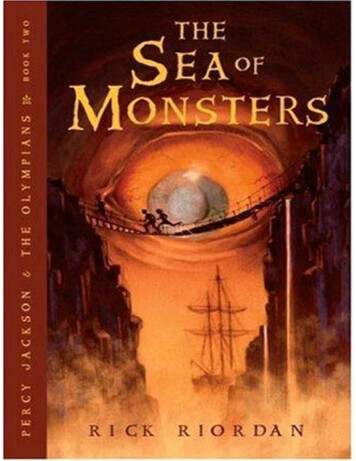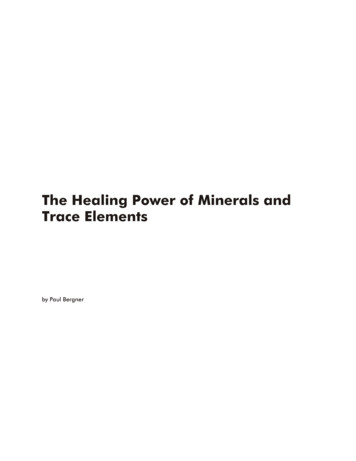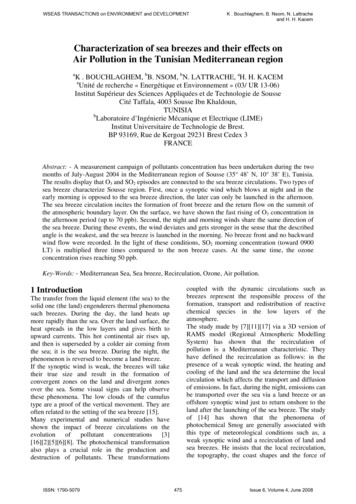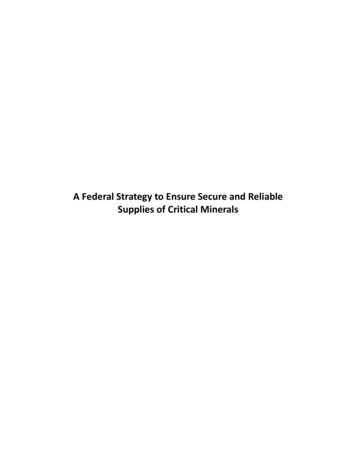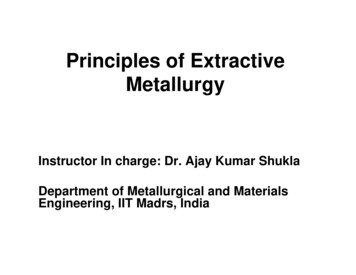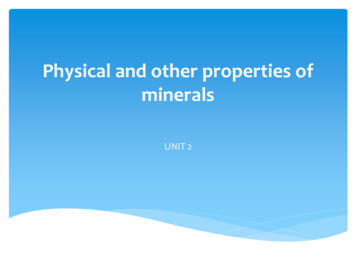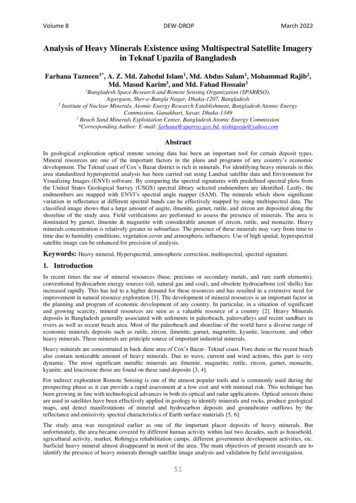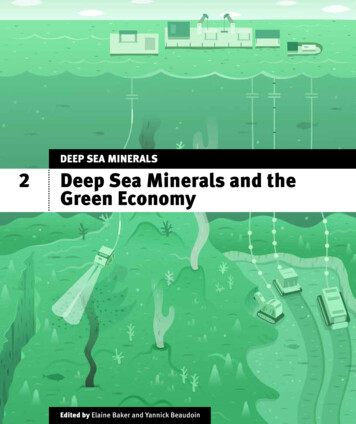
Transcription
DEEP SEA MINERALS2Deep Sea Minerals and theGreen EconomyEdited by Elaine Baker and Yannick BeaudoinDeep Sea Minerals and the Green Economy1
A Centre Collaborating with UNEPSteering CommitteeAkuila Tawake (Chair) Secretariat of the Pacific Community/SOPAC DivisionElaine Baker GRID-Arendal at the University of SydneyYannick Beaudoin GRID-ArendalMalcolm Clark National Institute of Water & Atmospheric Research Ltd (NIWA)Daniel Dumas The Commonwealth SecretariatChuck Fisher Penn State UniversityJames R. Hein United States Geological Survey (USGS)Robert Heydon Offshore CouncilHarry Kore Government of Papua New GuineaHannah Lily Secretariat of the Pacific Community/SOPAC DivisionMichael Lodge International Seabed AuthorityLinwood Pendleton Duke University, NOAASven Petersen GEOMARCharles Roche Mineral Policy InstituteJulian Roberts The Commonwealth SecretariatSamantha Smith Nautilus Minerals Inc.Anne Solgaard GRID-ArendalJan Steffen International Union for Conservation of NatureArthur Webb Secretariat of the Pacific Community/SOPAC DivisionGeoffroy Lemarche The National Institute of Water and Atmospheric ResearchPaul Lynch Government of the Cook IslandsGavin Mudd Monash UniversityChristian Neumann GRID-ArendalAntonio Pedro United Nations Economic Commission for AfricaRosmary Rayfuse University of New South WalesJonus Rupp Conservation InternationalRichard Schodde MinEx ConsultingAnnie Kwan Sing-Siose Secretariat of the Pacific Community/SOPAC DivisionNikki Teo University of SydneyDarryl Thorburn Government of the Cook IslandsMartin Tsamenyi University of WollongongRobin Warner University of WollongongEditorsElaine Baker and Yannick BeaudoinTechnical EditorsClaire EamerPatrick DaleyAuthorsElaine Baker GRID-Arendal at the University of SydneyYannick Beaudoin GRID-ArendalSara Bice University of MelbourneLee Burns University of SydneyDaniel Dumas The Commonwealth SecretariatJohn Feenan ICH MiningNick Hanley University of StirlingPorter Hoagland Woods Hole Oceanographic InstitutionPaula Holland Secretariat of the Pacific Community/SOPAC DivisionNiels Jobstvogt University of AberdeenHannah Lily Secretariat of the Pacific Community/SOPAC DivisionMichael Lodge The International Seabed AuthorityJulian Roberts The Commonwealth SecretariatLinwood Pendleton Duke UniversityAnne Solgaard GRID-ArendalPhilip Symonds University of WollongongCharles Roche Mineral Policy InstituteAkuila Tawake Secretariat of the Pacific Community/SOPAC DivisionReviewersJoshua Brien The Commonwealth SecretariatBill Edeson Forum Fisheries AgencyJohn Feenan IHC MiningMarea Hatziolos The World Bank2Deep Sea Minerals and the Green EconomyCartographyKristina Thygesen GRID-ArendalRiccardo Pravettoni GRID-ArendalFront CoverAlex l thanks to Akuila Tawake and Hannah Lily from the Secretariat of thePacific Community/SOPAC Division, Peter Harris from Geoscience Australia,and Allison Bredbenner from GRID-Arendal for final reviews of chapters.CitationSPC (2013). Deep Sea Minerals: Deep Sea Minerals and the GreenEconomy. Baker, E., and Beaudoin, Y. (Eds.) Vol. 2, Secretariat of thePacific CommunityISBN 978-82-7701-122-6 Copyright Secretariat of the Pacific Community (SPC) 2013All rights for commercial/for profit reproduction or translation, in anyform, reserved. SPC authorises the partial reproduction or translationof this material for scientific, educational or research purposes,provided that SPC and the source document are properly acknowledged.Permission to reproduce the document and/or translate in whole, inany form, whether for commercial/for profit or non-profit purposes,must be requested in writing. Original SPC artwork may not be altered orseparately published without permission.
4.0Sustainable EconomicDevelopment and DeepSea MiningLinwood Pendleton1, Anne Solgaard2 , Porter Hoagland3 , and Paula Holland4with additional contributions by Nick Hanley5 and Nils Jobstvogt61 Duke University2 GRID-Arendal3 Woods Hole Oceanographic Institution4 Secretariat of the Pacific Community/SOPAC Division5 University of Stirling6 University of AberdeenDeep Sea Minerals and the Green Economy41
Ensuring that deep sea mining will have a positive impact on Pacific Island communities requiressupporting not only the economic capital upon which sustainable and resilient economies arebuilt, but also the social and environmental capital. In this chapter, we will explore the potentialbenefits and costs of deep sea mining to the economic and environmental capital of coastal andsmall island developing states in the region. We also look at traditional and emerging ways todetermine the economic, environmental, and social costs and benefits of mining.42Deep Sea Minerals and the Green Economy
4.1Background: the oceanscape ofthe Pacific regionAlmost all of the currently estimated 10 million South Pacific islanders (expected to reach 15 million by 2035 (SPC 2013)), livewithin 50 kilometres of the coast. The ocean territory, which farexceeds the Pacific islands’ land mass, has shaped the lifestyles and culture of the people. The ocean provides fish, shellfish, and sea plants that support both local communities andcommercial fisheries. Coastal coral reefs and mangroves mitigate the impacts of storm surge and protect beaches. Coastalhabitats provide firewood, fibres, and other resources. Oceanviews are known to improve people’s well-being (MillenniumEcosystem Assessment 2005). Many coastal communities benefit from tourism, which generally relies on clean beaches, safewater, and abundant marine wildlife. Tourism generates jobs,income, and foreign exchange. Ocean recreation provides bothmarket and non-market benefits to coastal residents. Oceanecosystem processes provide ecological services and are an integral component of other global processes, such as the watercycle, nutrient cycling (including carbon storage), primary production of oxygen, and the regulation of climate.ecosystems that are so important to many Pacific communities.The lack of direct human uses of ecosystems and their servicesin the deep sea, combined with new technological advances,means that deep sea mining could potentially have lower environmental and social impacts than land-based mineral extraction(see Chapter 3 in this volume). Nevertheless, impacts could result, both onshore and offshore. The lack of information aboutthe ecosystems at depth and about the technology that will beemployed in commercial extraction activities offshore meansthat there remains scope for unforeseen and direct impacts. Additionally, the deep sea environment presents difficult workingconditions and unique technical issues that may make environmental monitoring and/or revenue collection difficult and costly.To ensure that any development of deep sea mining improvesthe overall well-being of society, it is essential to understandeach of the potential costs and benefits and their cumulative effects. Wealth creation from the sale of non-renewableresources needs to be weighed against any associated reduction in the economic value of other goods and services.By understanding this balance, policy makers can implementmeasures to ensure that the environmental and social costs ofdeep sea mining are managed and outweighed by the socialbenefits and economic returns from mining – and that thesereturns are invested and distributed equitably.The deep sea may now offer new opportunities for industrial development, including the extraction of minerals from the deepsea floor. Many existing industrial marine activities occur in thenear-shore environment, whereas deep sea mining activity is anticipated to be far removed from the coastal and shallow-waterWorld oceans, a cornucopia of goods and servicesWorldoceans,a cornucopiaof goodsservicesWorldoceans,a cornucopiaof goodsand andservicesO2O2O2O2 O2O2O2O2OO2O2O2O2O2O2O22O2O2O2O2O2NNNCO2CO2Figure 4.1 Marine ecosystem servicesCO2Source: GRID-ArendalSource: GRID-ArendalSource: GRID-ArendalDeep Sea Minerals and the Green Economy43
4.2A green economic approach tomanaging deep sea miningPacific Island developing states could potentially benefit fromseabed mining if these activities contribute to Pacific economies in a way that is both financially productive and alsogreen. A green economy is one in which market forces andopportunities are coupled with environmentally sound technologies to maintain or improve the economic, social, andenvironmental resource base on which coastal communitiesdepend. (See UNEP’s report Green Economy in a Blue World foradditional information, UNEP et al (2012)). In a greener economy, industry and business can contribute to creating newsources of income and jobs, while reducing the use of resources and the generation of waste (Figure 4.2). A green economycan also contribute to broader societal goals, such as sustainable development, social equity, and poverty reduction.A green economy can be viewed as an economic system thatis compatible with the natural environment and ecosystems,environmentally friendly, and socially just (Sheng 2010).Historically, Pacific communities have invested in their ownwelfare by converting their natural resources (fish, forests,mangroves, sand, etc.) into something of economic value. Theconversion of natural capital into economic capital has beenenvironmentally sustainable in many Pacific Island states,especially when the scale has been small and rules, whetherformal or not, have been in place to limit impacts on livingenvironmental resources. These rules are often based on anunderstanding of natural systems acquired over generations.As an example, in the Pacific, taboos on fishing have commonly been used to manage where and when fishermen couldcatch fish in such a manner that fish stocks are maintainedand continue to provide for the community. Managing theserenewable resources effectively meant giving something back:in this instance, the time and space necessary to replenishecosystem services.This approach to using renewable resources ensured that thewealth from fisheries was ongoing, or sustainable. Sustainingthe wealth generated from non-living resources, however, requires a different approach since non-living resources, such asdeep sea minerals, cannot be replenished. To account for thecontribution of natural capital to economic growth, deep seamining profits need to be invested in social and environmental capital, as well as in other forms of economic capital. Tosupport social capital, investments could create infrastructureand amenities that support the community, such as schools,hospitals, and other community facilities. Similar investmentscould be made in environmental protection or restoration,Building blocks of an inclusive Green edmetricsmarketssocialforinternational policiesLocalrightspoliciesmeasuring progressandandsupportcapacitiesSource: GRID-ArendalFigure 4.2 Principles of a green economy.44Deep Sea Minerals and the Green Economy
Three types of capital needed for a greener and more resilient economyNatural, economic, and social capitalSse ecurvECONgortinSuppsicervHealthservicesaleriat sM n e edledFred chanlihLiveoocr Valuea etioisinrv onice ingssutio rcesnoi omcectioialnsSo laresoRe llocaaA green economy endeavours to maximize returns on social and natural capital, as well as economic capital (Figure4.3). In a green economy, no single form of capital growsdisproportionately at the expense of the others (Figure 4.4).All three forms of capital can be depleted, but, if equitablymaintained, they can result in more resilient economies thatproduce sustainable value for the benefit of people.yrit esicSOCIALSCCAPITALraltu ceCu ervisA green economy is more holistic than a traditional economy focused primarily on economic growth. Instead, it recognizes three kinds of capital: Economic capital refers to standard forms of industrialcapital, including infrastructure such as roads, communications, plants, and equipment. Social capital includes knowledge, skills, and experiencecomprising the ability of human beings to contribute tothe production of economic value, as well as the broadersocial fabric in which it is embedded. This includes contributing to the cultural underpinnings of social institutions that, in turn, contribute to peace and sustainability. Natural capital includes the ability of the environment tosupport and produce goods and services that people value.LTAAL CAPITTURALANCAICPIMOse“A green economy is one that results in improved humanwell-being and social equity, while significantly reducingenvironmental risks and ecological scarcities. In its simplest expression, a green economy can be thought of as onewhich is low carbon, resource efficient and socially inclusive.” (UNEP 2011)dsovPr seSource: GRID-ArendalFigure 4.3 The three capitals of a green economy.The capitals need to be balancedSocial capitalEconomiccapitalNatural capitalSource: GRID-ArendalFigure 4.4 Balancing the three capitals.Deep Sea Minerals and the Green Economy45
thereby improving the value of local natural capital. In this respect, communities can obtain a net beneficial return from theextraction of sea-floor minerals.More generally, insufficient investment in social capital meansthat poverty could persist in the Pacific, despite any wealththat might be generated by mining. As an example, extensivemining development has been undertaken in Papua New Guinea in recent decades. Despite this, Papua New Guinea’s GDPper capita (recorded as US2187 in 2012, ranking 179th of 229countries worldwide; World Bank 2013) and human development index (recorded by UNDP in 2013 as 0.466, ranking 156thout of 187 countries worldwide; UNDP 2013) are still low, andpoverty remains in the communities close to the mines. Thisappears to be due to inadequate institutional capacity, ineffective management, and inequitable capture and reinvest-ment of resource rents. Lal and Holland (2010) give examplesof corruption, in which the wealth generated from the use ofcommunity-owned resources in Papua New Guinea has beenmanaged in a way that has not benefited local communities.Deep sea mining could contribute to a greener economy if: the economic benefits of deep sea mining exceed their economic costs; the environmental component of the costs of deep sea mining is adequately understood by all and is incorporated intothe decision making of deep sea mining companies (including management of consequences, as appropriate); and a sufficient share of the wealth generated by mining (for example, through taxes or royalties) is invested in social andenvironmental capital in order to ensure the sustainability ofwealth creation from finite resources.Limits to reinvestment of economic capital in natural capital: phosphate miningThe island of Kiribati provides an example of the value of investing the economic capital gained from a non-renewableresource in social capital. In the past, international companies carried out extensive phosphate mining on the islandof Banaba. As early as 1956, it was realized that the phosphate resources were limited and a trust fund – the Revenue Equalization Reserve Fund (RERF) – was establishedto manage the earnings from phosphate mining. Sincethen, interest from Kiribati’s phosphate royalties has beenavailable to the government and continues to be a critical46Deep Sea Minerals and the Green Economysource of budgetary income. In 2009, the fund was valuedat around US 570 million (IMF 2011).Nevertheless, reinvestment in social and natural capital canonly go so far towards ensuring basic levels of environmental quality. For instance, phosphate mining can still lead toirreversible environmental damage if appropriate environmental limits are not set. Phosphate mining has dramatically reduced the agricultural and fishing potential of morethan one Pacific Island state.
4.3Assessing the economicimpacts of deep sea miningLike any type of resource use, extracting deep sea minerals andgetting them to market can contribute to local environmentalchange, which could directly or indirectly compete with or displace other types of economic activity.At a minimum, Pacific Island states could capture a share ofthe economic return from mining by charging fees, taxes, androyalties, which provide public sector revenues that could bereinvested locally.4.3.1 The potential market benefits and costsof deep sea miningDeep sea mining is anticipated to be expensive. It is capital-intensive, requiring large expenditures on vessels and equipment, processing, and transportation (although, in contrast toland mining, much of the machinery is designed to be movedfrom site to site). Some of the expenses associated with deepsea mining operations might be spent in the host country,which could create macro-economic ripples leading to new jobsand revenues in the host country.Private companies are beginning to consider commercial deepsea mining because the minerals found on the sea floor havesubstantial value on the world market. The net market benefit ofthese resources (that is, profit) depends not only upon the market price of minerals and metals, but also on the financial costs ofexploration, permitting, management, extraction, and processing. The primary economic interest that Pacific Island states havein allowing or participating in deep sea mining is securing salesrevenue by way of royalties on mineral production, taxation onprofits, or access fees from foreign companies that require sovereign permission to access sea-floor resources. Such revenue, ifmanaged well, could inject new wealth into national economiesand have ripple effects throughout the national economy.In Papua New Guinea, for example, over the period 1996 to2000, the government raised revenue from mining through royalties, a mining levy on assessable mining income (in effect,an additional royalty), corporate income taxes and dividend-withholding taxes, an additional profits tax, and restrictionson deductions for off-site exploration expenditures (Otto et al2006). In addition, the state reserved the right to assume up toa 30-per-cent equity share in all projects at the time a mininglease was issued, at a price based on the project’s explorationcosts, not its full market value (Otto et al 2006).Although these charges were subsequently reduced andstreamlined, the magnitude of the potential wealth from miningin Papua New Guinea remains high, with mining consistentlycontributing between 10 and 20 per cent of national incomeover the years (Figure 4.5). Part of this wealth is also intended to reach communities, with the Papua New Guinea MiningAct requiring that owners of private land being mined receive ashare of the total royalty (Otto et al 2006).In practice, the degree to which these net market benefits willbe enjoyed nationally or locally will depend on a host of factors.Deep sea mining could also provide direct employment opportunities for a host country, indeed, this can be made a conditionof relevant mining law and agreement. But such employment willdepend upon the degree to which the administration, transport,and technical operations related to mining can be based locally.Potential sources of direct employment include shipping, aviation,warehousing, maintenance, construction, regulation, and monitoring (including laboratory services). In countries with well-developed labour forces – especially those where terrestrial miningalready exists – highly skilled or technically specialized positionscould be created for locals. In other Pacific Island states with lessdeveloped labour pools, migrant workers might (at least initially)fill highly skilled positions that could provide a basis for capacitybuilding and technology transfer opportunities, benefitting the social capital of coastal and small island developing states.Indirect employment – in hospitality, lodging, and provisioningindustries, for example – could be generated if mining operations buy goods and services locally. Mining operations mightalso require the development of new local infrastructure (suchas roads, ports, and power plants) that could serve to supportor spur needed infrastructure development in host countries –although there has, to date, been little indication from industryactors in the region that onshore services would be sought fromPacific Islands. If as seems likely, operations in the Pacific takeplace wholly offshore, with the seabed mineral ore being transported by boat out of the region’s ocean and directly to countries (perhaps in Asia) with established processing industries,then the potential benefits to be derived from employment orinfrastructure development should not be overstated.Deep Sea Minerals and the Green Economy47
Papua New Guinea gross domestic product from mining 56Gross domestic product (US million )1 7601 7111 8404 1584 2704 357Per cent of GDP from mining17.52121.514.612.710.5ActivityYearMining and quarrying (US million )Source: National Statistical Office of Papua New GuineaFigure 4.5 Gross domestic product from mining in Papua New Guinea. Source National Statistical Office of Papua New Guinea (2004)4.3.2 The potential non-market benefits ofdeep sea miningExploration and exploitation of the sea floor will contribute toadvances in technology and scientific understanding of theseareas. Already, exploration of the sea floor at potential miningsites (the Solwara 1 site within Papua New Guinea’s national jurisdiction and the Clarion-Clipperton Fracture Zone of the Area)has led to the discovery of previously unknown species and newinformation on biological processes (Van Dover et al 2012). It isdifficult to attribute an economic value to these scientific discoveries (although some commentators consider that geneticresources might be the real treasure to be found at depth in theocean), but it is clear that the costs of conducting research in theabsence of commercial exploration, driven by potential miningprofits, would likely be prohibitively high.The potential economic benefits of technological advances arealso difficult to quantify, but fall into two categories: advances that will improve the feasibility and profitability offuture deep sea mining; and advances that will benefit other industries (such as deep seatourism, cable laying, etc.).In all cases, these benefits are unlikely to be enjoyed directly bythe mining company, or even the Pacific Island states, but willhave substantial economic benefits outside the region.As noted, some habitats, organisms, and ecosystems that couldbe affected by deep sea mining might contribute to people’s economic well-being. Examples include food sources for commercially relevant fish, opportunities for scientific research, or po48Deep Sea Minerals and the Green Economytentially valuable genetic resources for biotechnology or medicalapplications. Future tourism to deep sea areas via submarine orthrough images is also a possibility. Commercial fishing, scientific research, and tourism all have direct value, known as use value, which can be estimated by market and non-market methods.If deep sea mining has detrimental impacts on these ecosystemservices, the loss of value associated with these changes shouldbe understood and considered by policy makers.Deep sea mining is presented by some mining companies as amore environmentally sound alternative to terrestrial mining forsimilar minerals (see Chapter 3). Whether or not deep sea miningwill ever displace terrestrial mining depends on a host of factors,including market forces, regulations for terrestrial and sea-floormining, and the degree to which environmental externalities areincorporated into the cost of doing business.4.3.3 The potential non-market costs associated with deep sea miningIt is possible that deep sea habitats, ecosystems, and organisms have value that is not associated with direct use, includingthe value people place on simply knowing they exist (existencevalue), the value of saving these deep sea areas for future users(bequest value), and the value of future potential uses for thesedeep sea areas (option value). Such values depend, in part, onour understanding of the ecosystems, and some recognition ofpotential future uses (for example, biotechnologies, medical applications, recreation sites, linkages to proximate benthic andpelagic ecosystems, etc.) may be warranted. Our knowledge ofthese systems and of the options for potential future use is likelyto grow rapidly with further exploration and research.
Environmental changes that could result from deep sea miningDeep sea mining will cause direct physical changes in thestructure of the seabed, as well as in the quality of the physical environment and the nature of environmental processesin the immediate vicinity (see Volume 1 of this series). Miningof sea-floor massive sulphides and cobalt-rich ferromanganese crusts might require strip-mining techniques that useremotely operated underwater cutters to remove the ore.Manganese nodule mining might use a vacuum system. Stripmining and sea-floor vacuuming could destroy the physicalhabitat of deep sea-floor areas and associated biota (see Elements of Production, below). Without careful controls, deepsea mining could release particulate matter into the watercolumn, both from the cutting process and from the return ofturbidity-laden seawater from the shipboard dewatering process (Hoagland et al 2010). This release could be detrimental to organisms living close to the mine site, and potentiallyalso those farther away.Access to some parts of the sea may be diminished if deepsea mining activity at the lift/riser site requires a management or exclusion zone. Similar access restrictions couldoccur due to the marine traffic associated with support vessels. Noise, sediments, and other associated factors couldcreate a de facto exclusion zone. Displacement of artisanal orindustrial fishing would result in a further cost associatedwith mining activities.Mining might also affect nearby organisms through the introduction of invasive species, toxic substances from the deposit, spilt ore, and such pollutants as hydraulic fluids, noise,and vibration. In addition, mining introduces light into anotherwise dark world, which could potentially interfere withthe feeding and reproductive behaviour of organisms (Nautilus Minerals 2008).Getting marine minerals from the sea floor to market requiresa production chain that could affect a wide range of environments, not only those directly associated with the deposit.Onshore operations, which may include infrastructure development, ore transfers, crew transfers, and minerals processing and transport, have the potential to affect local water andair quality and result in carbon emissions. A reduction in local environmental quality could also pose a public health riskto local communities. The potential economic costs of theseenvironmental damages have not yet been estimated.It should also be recognized that some environmental damage may have only a small impact on societal well-being.Deep Sea Minerals and the Green Economy49
4.4The economic costs ofenvironmental mitigation andpollution reductionIn order to reduce the potential environmental impacts ofmining, deep sea mineral extractors will likely be compelledto follow the industry’s Code for Environmental Managementof Marine Mining (IMMS 2011). Governments and the International Seabed Authority will require that the mining companyand its partner organizations undertake steps to mitigate andreduce environmental impacts. For instance, a recent publication by the International Seabed Authority (Van Dover etal 2011) on the environmental management of deep sea che-mosynthetic ecosystems put forward guidelines (the DinardGuidelines) aimed at protecting the natural diversity, ecosystem structure, function, and resilience of chemosyntheticecosystems, while enabling rational use. While efforts to reduce environmental impacts may result in savings by avoiding losses in ecosystem services, many such environmentalprotection activities represent real economic costs that mustalso be considered in weighing the potential value of deepsea mining.Macroeconomic impacts of deep sea miningThe potential economic benefits and costs of deep sea mining affect the overall level of wealth injected into a country.At the same time, the generation of market values (revenuesand financial costs) can be expected to create knock-on effectsthroughout the economy.Revenue generated from deep sea minerals could allow national governments to provide services previously out of financialreach, such as new hospitals, schools, or roads. In so doing,local engineering firms, contracted to do the work, might beexpected to employ new staff. These workers would then havemoney to buy food and pay for housing in the community. Withincreased sales revenue and housing costs, local businessesmight experience a small boom, and they in turn might take onadditional staff who would buy more products.In this way, the market benefits of deep sea mining (earningsand investment) can spread throughout the national economy.However, not all economic impacts of deep sea mining are likelyto be beneficial. First, macro-economic ripple effects generated50Deep Sea Minerals and the Green Economyfrom deep sea mining will only be sustainable for as long as thenational benefits of deep sea mining exceed the national costs.Even industries running at a loss can maintain employmentand support local shops and service industries while moneyis pumped into them. However, income pumped into failing industries will be deflected from other industries where nationalbenefits might be higher than costs and where positive rippleeffects could be generated without support. As a result, continuing investment in the sector, if deep sea mining is unprofitable,would likely occur at the expense of other areas of the economy.F
Figure 4.1 Marine ecosystem services ecosystems that are so important to many Pacific communities. The lack of direct human uses of ecosystems and their services in the deep sea, combined with new technological advances, means that deep sea mining could potentially have lower envi-ronmental and social impacts than land-based mineral extraction
